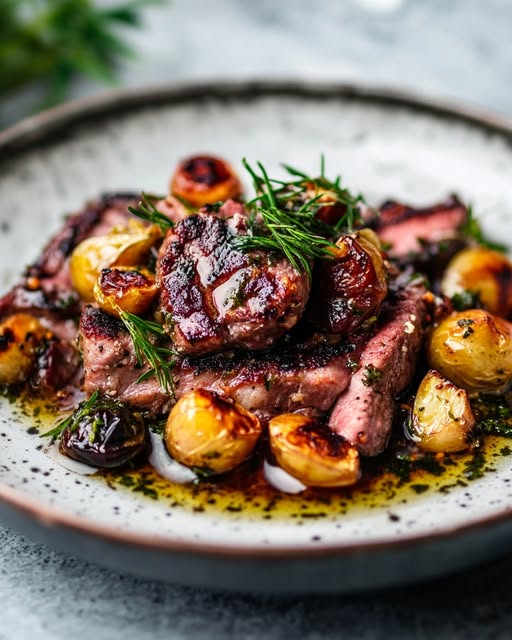A Garlic Octopus Delight That’ll Make You Fall in Love
Picture this: a sunny Sunday afternoon at my house, with the aroma of garlic and olive oil wafting through the air. I decided to try something new—Garlic Octopus Delight. It was an instant hit! The tender octopus paired with zesty garlic, fresh parsley, and a splash of lemon made it unforgettable. Whether you’re hosting a fancy dinner or craving a Mediterranean-inspired snack, this dish will steal the show.
The Story Behind This Flavorful Dish
This Garlic Octopus Delight recipe has roots in Mediterranean cuisine, where seafood is celebrated for its freshness and simplicity. Traditionally, octopus is slow-cooked to perfection, allowing it to absorb flavors while becoming irresistibly tender. I first tasted a version of this dish during a trip to Greece. Sitting by the sea, savoring tender octopus with a tangy garlic sauce, I knew I had to recreate it at home. Over time, I’ve added my own twist, like a hint of chili flakes for a subtle kick.
Why You’ll Love This Recipe
Let’s talk about why this dish deserves a spot on your menu. First, it’s packed with flavor—garlic, parsley, and olive oil create a symphony of taste that’s both comforting and exciting. Second, it’s surprisingly easy to make. No fancy techniques here—just a bit of patience while the octopus cooks. Plus, it’s versatile. Serve it warm as a main course or chilled as an appetizer. Trust me, your guests will rave about it!
Perfect Occasions to Prepare This Recipe
This Garlic Octopus Delight shines at gatherings where you want to impress without spending hours in the kitchen. It’s perfect for summer barbecues, holiday feasts, or even a cozy date night. I once served it at a friend’s birthday party, and everyone kept asking for seconds. It’s also great for meal prep—you can make it ahead and enjoy it later in the week.
Ingredients
- 1 kg of fresh octopus
- 6 cloves of garlic, thinly sliced
- Juice of half a lemon
- 1 tablespoon red wine vinegar
- 4 tablespoons extra virgin olive oil
- A handful of fresh parsley, finely chopped
- ½ teaspoon red pepper flakes (optional)
- 2 bay leaves
- 1 tablespoon whole black peppercorns
- Salt and freshly ground black pepper to taste
Substitution Options
No octopus? No problem! You can use squid or shrimp as alternatives. If you’re not a fan of spicy food, skip the red pepper flakes. For a tangier sauce, swap the red wine vinegar with balsamic vinegar. Fresh herbs like cilantro or dill can replace parsley if needed. Lastly, sunflower oil works fine if you don’t have olive oil, though the flavor won’t be quite as rich.
Step 1: Preparing the Octopus
Start by giving your octopus some love. In a large, heavy-bottomed pot, heat a tablespoon of olive oil over medium heat. Toss in the bay leaves and peppercorns—they’ll infuse the octopus with earthy notes. Once the oil shimmers, gently place the octopus inside and cover the pot. The aroma of bay leaves mingling with olive oil is simply divine. Pro tip: Don’t overcrowd the pot; give the octopus room to breathe.
Step 2: Cooking the Octopus
Now comes the magic. Let the octopus simmer away for 45 minutes to an hour. Keep the lid on—it traps all those delicious juices. As it cooks, the tentacles transform from chewy to melt-in-your-mouth tender. Peek occasionally to ensure the liquid doesn’t evaporate completely. If it does, add a splash of water. When a fork slides easily into the thickest part, you know it’s ready.
Step 3: Cooling Down
Once the octopus is cooked, remove it from the pot and let it rest. Save a little of the cooking liquid—it’s liquid gold for enhancing the sauce later. While the octopus cools, take a moment to admire its glossy sheen. Isn’t it beautiful? Patience pays off here; cooling prevents the meat from tearing when you slice it.
Step 4: Making the Sauce
In a small bowl, whisk together the remaining olive oil, red wine vinegar, minced garlic, chopped parsley, lemon juice, and red pepper flakes. This vibrant sauce is the heart of the dish. The sharpness of the lemon balances the richness of the olive oil, while the garlic adds depth. Stir well until everything blends harmoniously. Chef’s tip: Taste and adjust seasoning before mixing it with the octopus.
Step 5: Cutting the Octopus
Using a sharp knife, cut the octopus tentacles into bite-sized pieces, about 3 cm long. Place them in a large bowl. Look at those glossy, curly tentacles—they’re ready to soak up the flavorful sauce. Handling the octopus is satisfying; it feels firm yet tender, a sign you’ve nailed the cooking process.
Step 6: Mixing Everything Together
Pour the sauce over the octopus pieces and toss gently to coat. Add a spoonful of the reserved cooking liquid for extra flavor. Watch how the sauce clings to every piece, creating a glossy finish. This step ensures every bite bursts with garlicky goodness. Season with salt and pepper to suit your taste.
Step 7: Garnishing and Serving
Before serving, sprinkle additional chopped parsley on top for a pop of color. Arrange the Garlic Octopus Delight on a platter or individual plates. Serve it warm or chilled—it’s delicious either way. Pair it with crusty bread or a crisp salad for a complete meal.
Timing
Prepping takes about 30 minutes, mainly slicing garlic and chopping parsley. Cooking the octopus requires 45 minutes to an hour, depending on its size. There’s no resting time, so you can dive right in once it’s done. Total time? Roughly 1 hour and 30 minutes. Worth every minute!
Chef’s Secret
Here’s a little secret: freezing the octopus overnight before cooking makes it incredibly tender. The ice crystals break down tough fibers, ensuring a softer texture. Just thaw it in the fridge before using.
Extra Info
Did you know octopus contains high levels of omega-3 fatty acids? These healthy fats are great for your heart and brain. Plus, it’s low in calories, making it a guilt-free indulgence.
Necessary Equipment
You’ll need a large pot with a heavy bottom, a sharp knife, a cutting board, a mixing bowl, and a whisk. A pair of tongs helps handle the hot octopus safely.
Storage
To store leftovers, transfer the dish to an airtight container. It keeps well in the fridge for up to two days. The flavors deepen over time, making it even tastier the next day. Always reheat gently to preserve the tender texture.
If you plan to freeze it, portion it into smaller servings. Wrap tightly in plastic wrap before placing it in a freezer-safe bag. Consume within three months for best quality.
When reheating, avoid microwaving, as it can dry out the octopus. Instead, warm it slowly in a skillet with a drizzle of olive oil. This method keeps it moist and flavorful.
Tips and Advice
Invest in good-quality extra virgin olive oil—it truly elevates the dish. Use fresh herbs whenever possible; dried ones lack the same vibrancy. Finally, don’t rush the cooking process. Slow and steady wins the race when it comes to tender octopus.
Presentation Tips
- Serve on a rustic wooden board for a Mediterranean vibe.
- Garnish with lemon wedges for a pop of color.
- Drizzle a final touch of olive oil before serving.
Healthier Alternative Recipes
Option 1: Swap the octopus with grilled zucchini slices for a vegetarian twist.
Option 2: Use less olive oil and add a splash of vegetable broth for a lighter sauce.
Option 3: Replace red pepper flakes with smoked paprika for a milder kick.
Option 4: Add cherry tomatoes for natural sweetness and juiciness.
Option 5: Mix in quinoa or bulgur wheat for a protein-packed base.
Option 6: Serve alongside steamed green beans instead of bread.
Mistake 1: Skipping the Freezing Step
Many beginners skip freezing the octopus, which results in tougher meat. Freezing softens the fibers naturally. To avoid this mistake, plan ahead and freeze the octopus overnight.
Mistake 2: Overcooking the Octopus
Overcooked octopus turns rubbery, ruining the texture. Stick to the recommended cooking time and test for tenderness with a fork. Pro tip: Tentacles curl slightly when perfectly cooked.
Mistake 3: Using Old Herbs
Fresh herbs make a world of difference. Dried parsley lacks the brightness needed for this dish. Always opt for fresh herbs to capture authentic Mediterranean flavors.
FAQ
Can I Use Frozen Octopus?
Absolutely! In fact, frozen octopus often cooks up more tender than fresh. Just thaw it in the fridge overnight before starting the recipe.
How Do I Know When the Octopus Is Done?
The octopus is ready when a fork easily pierces the thickest part. The tentacles should feel soft and slightly curled.
What Can I Substitute for Red Wine Vinegar?
Balsamic vinegar or apple cider vinegar works well. Both add a tangy note that complements the dish beautifully.
Is This Dish Spicy?
It can be, depending on how much red pepper flakes you use. Start with a small amount and adjust to your preference.
Can I Make This Ahead of Time?
Yes! This dish tastes even better the next day. Store it in the fridge and serve it cold or at room temperature.
What Should I Serve With It?
Crusty bread, roasted potatoes, or a simple arugula salad pair wonderfully with this dish.
How Long Does It Keep?
Stored properly in the fridge, it lasts up to two days. Freeze it for longer storage, but consume within three months.
Can I Grill the Octopus Instead?
Yes! After boiling, pat the octopus dry and grill it briefly for a smoky flavor. Slice and mix with the sauce afterward.
What If I Don’t Have Bay Leaves?
Oregano or thyme can work as substitutes, though bay leaves provide a unique aroma that enhances the dish.
Is This Dish Gluten-Free?
Yes, it’s naturally gluten-free. Just ensure all ingredients, like vinegar, are certified gluten-free if needed.
Final Thoughts
There’s something magical about Garlic Octopus Delight. Its simplicity lets the star ingredients shine, while its bold flavors leave a lasting impression. Whether you’re a seasoned cook or a beginner, this recipe is approachable and rewarding. So grab some octopus, channel your inner chef, and treat yourself to a Mediterranean feast. Bon appétit!

Garlic Octopus Delight
Ingredients
Equipment
Method
- In a large, heavy-bottomed pot, heat a tablespoon of olive oil over medium heat; add bay leaves and peppercorns.
- Gently place the octopus inside and cover the pot; let simmer for 45 minutes to an hour.
- Once cooked, remove the octopus and let it rest while saving some cooking liquid.
- In a small bowl, whisk together remaining olive oil, red wine vinegar, minced garlic, chopped parsley, lemon juice, and red pepper flakes.
- Cut the octopus tentacles into bite-sized pieces, about 3 cm long, and place in a large bowl.
- Pour the sauce over the octopus and toss gently to coat, adding reserved cooking liquid for extra flavor.
- Garnish with additional parsley before serving; serve warm or chilled as desired.
